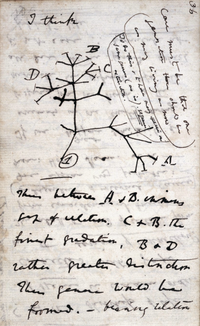
Photo from wikipedia
Aim of this study was a genome‐wide identification of mechano‐regulated genes and candidate pathways in human chondrocytes subjected to a single anabolic loading episode and characterization of time evolution and… Click to show full abstract
Aim of this study was a genome‐wide identification of mechano‐regulated genes and candidate pathways in human chondrocytes subjected to a single anabolic loading episode and characterization of time evolution and re‐inducibility of the response. Osteochondral constructs consisting of a chondrocyte‐seeded collagen‐scaffold connected to β‐tricalcium‐phosphate were pre‐cultured for 35 days and subjected to dynamic compression (25% strain, 1 Hz, 9 × 10 min over 3 hr) before microarray‐profiling was performed. Proteoglycan synthesis was determined by 35S‐sulfate‐incorporation over 24 hr. Cell viability and hardness of constructs were unaltered by dynamic compression while proteoglycan synthesis was significantly stimulated (1.45‐fold, p = 0.016). Among 115 significantly regulated genes, 114 were up‐regulated, 48 of them ≥ twofold. AP‐1‐relevant transcription factors FOSB and FOS strongly increased in line with elevated ERK1/2‐phosphorylation and rising MAP3K4 expression. Expression of proteoglycan‐synthesizing enzymes CHSY1 and GALNT4 was load‐responsive as were factors associated with the MAPK‐, TGF‐β‐, calcium‐, retinoic‐acid‐, Wnt‐, and Notch‐signaling pathway which were significantly upregulated SOX9, and BMP6 levels rose significantly also after multiple loading episodes at daily intervals even at the 14th cycle with no indication for desensitation. Canonical pSmad2/3 and pSmad1/5/9‐signaling showed no consistent regulation. This study associates novel genes with mechanoregulation in chondrocytes, raising SOX9 protein levels with anabolic loading and suggests that more pathways than so far anticipated apparently work together in a complex network of stimulators and feedback‐regulators. Upregulation of mechanosensitive indicators extending differentially into the resting time provides crucial knowledge to maximize cartilage matrix deposition for the generation of high‐level cartilage replacement tissue.
Journal Title: Journal of Cellular Physiology
Year Published: 2018
Link to full text (if available)
Share on Social Media: Sign Up to like & get
recommendations!